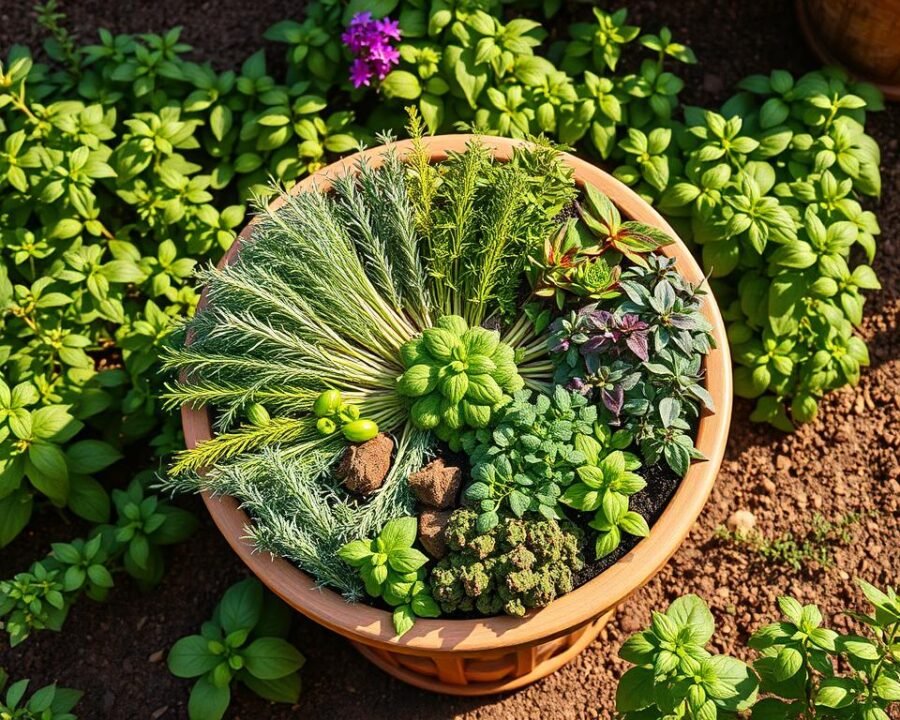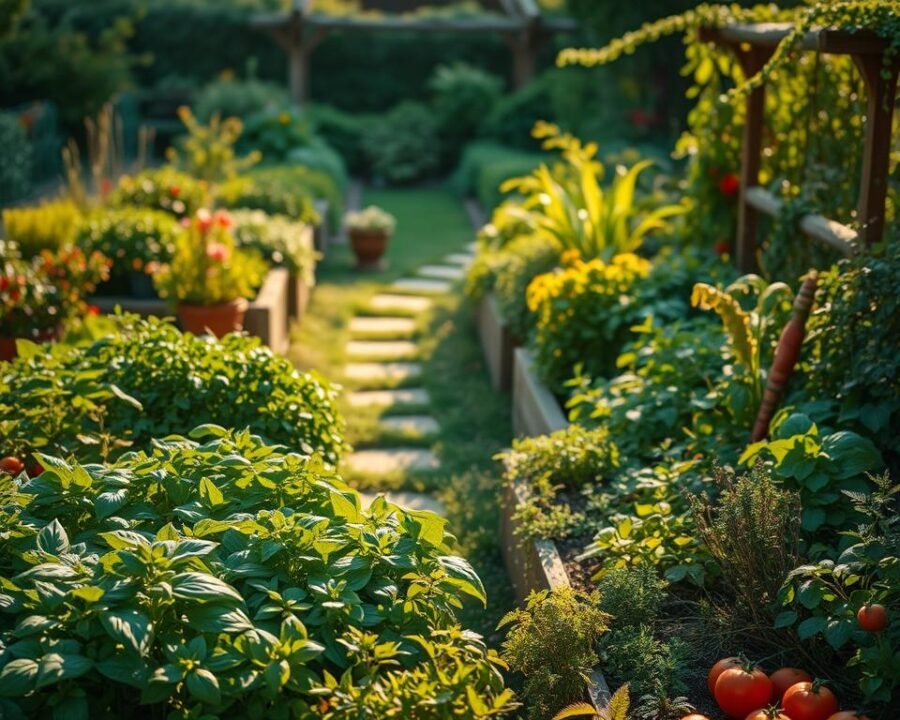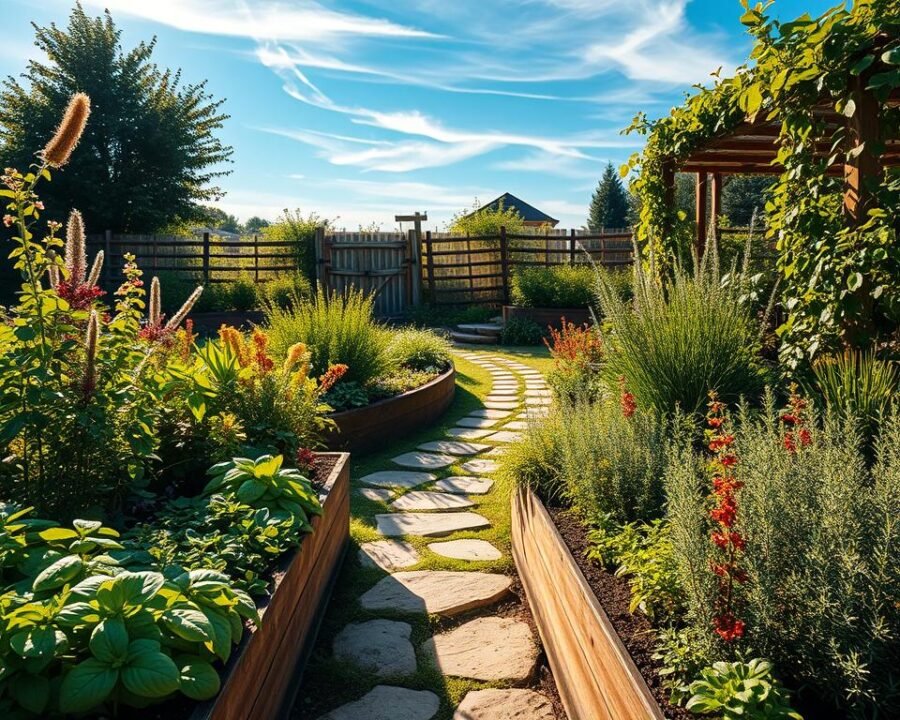Explore the Best Herb Garden Designs Layouts You Need to Try
There’s something magical about stepping outside and snipping fresh herbs for a meal. The aroma of basil, the crispness of mint—it turns cooking into an experience. Whether you have a sprawling backyard or a tiny balcony, growing your own plants brings joy and flavor to everyday life.
This guide covers creative ways to cultivate herbs in any space. From compact vertical setups to sprawling Mediterranean spirals, there’s a layout for every home. Fresh plants don’t just enhance meals—they support pollinators and offer natural remedies.
We’ll share practical tips for beginners and inventive ideas for seasoned growers. Raised beds, repurposed containers, and even windowsill solutions are all on the table. Let’s dig into designs that blend beauty and functionality.
Key Takeaways
- Fresh herbs elevate cooking and support pollinators.
- Layouts adapt to small balconies or large yards.
- Vertical and container designs maximize limited space.
- Raised beds simplify maintenance and improve drainage.
- Creative setups like herb spirals add visual appeal.
Choosing the Right Herbs for Your Garden
Fresh flavors start with smart herb selection. Whether for cooking, teas, or attracting bees, each plant serves a purpose. We’ll explore top picks for every need.
Culinary and Medicinal Stars
Basil and parsley shine in the kitchen, while chamomile soothes as tea. Mediterranean herbs like rosemary and thyme grow well in poor soil and full sun.
Annual vs. Perennial Herbs
Annuals (basil, cilantro) complete their cycle in one season. Perennials like sage return yearly. Mix both for continuous harvests.
| Type | Examples | Care Tips |
|---|---|---|
| Annual | Basil, Dill | Plant yearly; rich soil |
| Perennial | Thyme, Oregano | Prune spring/fall |
Pollinator-Friendly Picks
Lavender and borage attract bees but need space. Avoid planting mint in beds—it spreads aggressively. Use pots to control roots.
For organic seeds, try Baker Creek or High Mowing. Their non-GMO options ensure healthy starts.
Basic Herb Garden Designs to Get Started
Three foundational setups transform any space into a thriving green corner. These designs balance simplicity and functionality, perfect for first-time growers.

The Classic Herb Wheel
This circular layout keeps aggressive mint contained while showcasing seven companion varieties. Start by marking a 4-foot circle with sand. Sink a large pot at the center for mint—its roots won’t invade neighboring plants.
- Divide the wheel into wedges like a pie chart.
- Plant rosemary, thyme, and sage in sunnier sections.
- Add parsley and chives to shadier spots.
“Herb wheels are timeless. They’re practical and turn gardening into an art form.”
Spiral Herb Gardens
Stone or brick spirals create microclimates for diverse herbs. Build upward with compost-rich soil, ensuring a 2-foot width for easy access. Mediterranean varieties thrive at the sun-drenched top, while moisture-loving cilantro settles near the base.
| Material | Pros | Cons |
|---|---|---|
| Natural Stone | Rustic look | Heavy to move |
| Brick | Precise shaping | Less drainage |
Raised Bed Layouts
Elevated beds solve drainage issues, especially in clay-heavy areas. Limit width to 4 feet to avoid overreaching. For Mediterranean herbs, mix 30% grit into the soil to mimic their native terrain.
Layer veg scraps at the bottom as slow-release compost. This trick reduces waste and feeds plants over time. Explore more herb garden design ideas for customizing your setup.
Best Herb Garden Designs Layouts You Need to Try for Larger Spaces
Expansive outdoor areas offer exciting opportunities for diverse herb cultivation. With more room, we can experiment with mixed plantings, dedicated beds, and organic pest solutions. These designs maximize yield while supporting ecosystems.

Mixed Herb and Vegetable Gardens
Companion planting boosts growth and deters pests naturally. Basil pairs perfectly with tomatoes, enhancing flavor and repelling flies. Dill safeguards cabbage from harmful caterpillars.
For pollinator support, plant fennel and bee balm between vegetable rows. These “corridors” attract beneficial insects. Tagetes (marigolds) protect beans from aphids without chemicals.
Dedicated Herb Beds
Specialized beds simplify harvesting and care. Chamomile thrives in bulk plantings for tea lovers—space oregano and thyme 18 inches apart for drying. Their woody stems need airflow.
- Rotate biennial parsley patches yearly to prevent soil depletion.
- Intercrop fast-growing chives with slower perennials like sage.
Organic Pest Control with Herbs
Herbs like mint and garlic double as natural repellents. A simple spray combines:
- 1 cup crushed mint leaves
- 3 minced garlic cloves
- 2 cups water (steep overnight, strain)
Spritz on leaves to deter aphids. Avoid synthetic sprays—they harm pollinators and soil health.
Creative Container Herb Garden Ideas
Containers bring flexibility to growing fresh flavors, even in tight corners. From sunny windowsills to shaded patios, these setups adapt to any space. Let’s explore inventive ways to cultivate herbs without sacrificing style.

Window Boxes and Small-Space Solutions
Compact areas shine with vertical plantings. Cedar window boxes resist rot, while metal ones offer sleek modern lines. Line them with landscape fabric to retain soil.
- Sun-loving varieties: Basil, oregano, and thyme thrive in 6+ hours of light.
- Shade-tolerant picks: Chives and parsley flourish with indirect sunlight.
Repurposed Containers with Character
Old wheelbarrows or wine crates add rustic charm. Drill drainage holes and layer gravel beneath soil. For wheelbarrows, use pond liner to prevent rust stains.
“Vintage containers tell a story. They blend function with nostalgia.”
Self-Watering Systems for Busy Homes
Recycled bottles with watering spikes keep plants hydrated for days. Commercial self-watering pots like AquaSprouts automate care, ideal for summer trips.
- Insert a spike into the pot’s soil.
- Fill a bottle and invert it into the spike.
- Refresh every 5–7 days.
For Mediterranean flair, pair terra cotta pots with blue accents. Upgrade rosemary to a 24-inch container every two years as roots expand.
Essential Tips for Maintaining Your Herb Garden
Keeping herbs thriving requires simple but consistent care. With the right routines, plants reward us with fresh flavors and lush growth. Let’s explore how to nurture them through every season.
Watering and Fertilizing
Deep, infrequent watering encourages strong roots. Check soil moisture by sticking a finger 1 inch deep—dry means it’s time to hydrate. Morning watering reduces evaporation loss.
Feed plants with compost in spring for slow-release nutrients. In summer, switch to liquid comfrey or seaweed tea every 3 weeks. These natural boosts enhance post-harvest regrowth.
Pruning and Harvesting
Trim basil just above leaf nodes for a “cut-and-come-again” yield. For woody herbs like rosemary, prune after flowering to maintain shape.
- Divide chives every 3 years: Dig clumps, separate roots, and replant.
- Pinch back oregano to prevent leggy growth.
Winter Care for Perennial Herbs
In Zones 7–10, rosemary survives outdoors with straw mulch. Colder regions? Pot it and move indoors. Lemongrass needs a sunny windowsill and reduced watering.
“Hardening off over 7 days prevents shock when transitioning plants indoors.”
Compare mulches: Straw insulates better than bark but may harbor seeds. For sage and thyme, skip heavy covers—they prefer dry winter air.
Conclusion
Cultivating fresh herbs transforms any space into a flavorful retreat. From compact spirals to sprawling pollinator beds, these layouts adapt to every home. Each design offers unique benefits—raised beds simplify care, while mixed container setups maximize small areas.
Experiment with themed plantings or repurposed pots for personality. Homegrown plants outshine store-bought ones in aroma and taste. Share your creations online to inspire fellow growers.
Pro tip: Track progress in a journal. Note which seeds thrive and when to harvest. This simple habit boosts success year after year.
Ready to start? Grab a pot, pick your favorite herbs, and let nature handle the rest. The kitchen will thank you.







